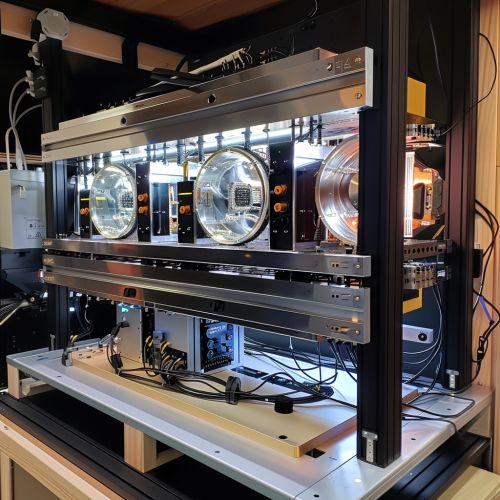Pauli-Z: Difference between revisions
(Created page with "== Introduction == The Pauli-Z operator, often denoted as \( \sigma_z \) or \( Z \), is one of the fundamental Pauli matrices in quantum mechanics and quantum computing. Named after the physicist Wolfgang Pauli, these matrices are essential in the study of quantum systems, particularly in the context of quantum spin and quantum information theory. The Pauli-Z operator plays a crucial role in various quantum algorithms and is a cornerstone in the represent...") |
No edit summary |
||
| Line 56: | Line 56: | ||
* [[Quantum error correction]] | * [[Quantum error correction]] | ||
[[Image:Detail-93105.jpg|thumb|center|A modern quantum computer setup with visible qubits and control systems.|class=only_on_mobile]] | |||
[[Image:Detail-93106.jpg|thumb|center|A modern quantum computer setup with visible qubits and control systems.|class=only_on_desktop]] | |||
== References == | == References == | ||
Latest revision as of 23:27, 21 June 2024
Introduction
The Pauli-Z operator, often denoted as \( \sigma_z \) or \( Z \), is one of the fundamental Pauli matrices in quantum mechanics and quantum computing. Named after the physicist Wolfgang Pauli, these matrices are essential in the study of quantum systems, particularly in the context of quantum spin and quantum information theory. The Pauli-Z operator plays a crucial role in various quantum algorithms and is a cornerstone in the representation of quantum states and operations.
Mathematical Definition
The Pauli-Z operator is defined as a 2x2 Hermitian matrix: \[ \sigma_z = \begin{pmatrix} 1 & 0 \\ 0 & -1 \end{pmatrix} \]
This matrix is one of the three Pauli matrices, the others being Pauli-X (\( \sigma_x \)) and Pauli-Y (\( \sigma_y \)). The Pauli-Z operator acts on the state vectors in a two-dimensional Hilbert space, typically representing the basis states of a single qubit.
Properties
Eigenvalues and Eigenvectors
The eigenvalues of the Pauli-Z operator are +1 and -1. The corresponding eigenvectors are: \[ |0\rangle = \begin{pmatrix} 1 \\ 0 \end{pmatrix} \quad \text{and} \quad |1\rangle = \begin{pmatrix} 0 \\ 1 \end{pmatrix} \]
These eigenvectors form the computational basis for a single qubit, often referred to as the "standard basis" or "computational basis" in quantum computing.
Commutation Relations
The Pauli-Z operator, along with the other Pauli matrices, satisfies specific commutation and anti-commutation relations. The commutation relations are given by: \[ [\sigma_i, \sigma_j] = \sigma_i \sigma_j - \sigma_j \sigma_i = 2i \epsilon_{ijk} \sigma_k \] where \( i, j, k \) are indices corresponding to x, y, z, and \( \epsilon_{ijk} \) is the Levi-Civita symbol.
The anti-commutation relations are: \[ \{\sigma_i, \sigma_j\} = \sigma_i \sigma_j + \sigma_j \sigma_i = 2 \delta_{ij} I \] where \( \delta_{ij} \) is the Kronecker delta and \( I \) is the identity matrix.
Hermiticity and Unitarity
The Pauli-Z operator is both Hermitian and unitary. Hermiticity implies that \( \sigma_z \) is equal to its own conjugate transpose: \[ \sigma_z^\dagger = \sigma_z \]
Unitarity means that the product of \( \sigma_z \) with its conjugate transpose yields the identity matrix: \[ \sigma_z \sigma_z^\dagger = I \]
Physical Interpretation
In the context of quantum mechanics, the Pauli-Z operator is often associated with the measurement of the spin of a particle along the z-axis. For a spin-1/2 particle, such as an electron, the eigenvalues +1 and -1 correspond to the spin being aligned or anti-aligned with the z-axis, respectively.
In quantum computing, the Pauli-Z operator is used to flip the phase of the qubit state \( |1\rangle \) while leaving the state \( |0\rangle \) unchanged. This operation is crucial in various quantum algorithms and error correction codes.
Applications in Quantum Computing
Quantum Gates
The Pauli-Z operator is used to construct various quantum gates, including the Z-gate, which is a single-qubit gate represented by the matrix \( \sigma_z \). The Z-gate is a fundamental gate in the quantum circuit model and is used in combination with other gates to perform more complex quantum operations.
Quantum Error Correction
In quantum error correction, the Pauli-Z operator is used to detect and correct phase flip errors. It is a part of the Pauli group, which consists of all possible products of the Pauli matrices and the identity matrix. The Pauli group is essential in the design of stabilizer codes and other error-correcting codes.
Quantum Algorithms
The Pauli-Z operator is employed in various quantum algorithms, such as the Quantum Fourier Transform and Grover's algorithm. It is used to manipulate the phases of quantum states, which is a critical aspect of quantum computation.
Experimental Realizations
The implementation of the Pauli-Z operator in physical quantum systems varies depending on the technology used. In superconducting qubits, the Z-gate can be realized using microwave pulses or flux biasing. In trapped ion qubits, the Z-gate can be implemented using laser pulses.
See Also


